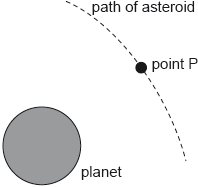| Date | November 2017 | Marks available | 1 | Reference code | 17N.2.HL.TZ0.2 |
| Level | Higher level | Paper | Paper 2 | Time zone | 0 - no time zone |
| Command term | Outline | Question number | 2 | Adapted from | N/A |
Question
There is a proposal to power a space satellite X as it orbits the Earth. In this model, X is connected by an electronically-conducting cable to another smaller satellite Y.
Satellite Y orbits closer to the centre of Earth than satellite X. Outline why
The cable acts as a spring. Satellite Y has a mass m of 3.5 x 102 kg. Under certain circumstances, satellite Y will perform simple harmonic motion (SHM) with a period T of 5.2 s.
Satellite X orbits 6600 km from the centre of the Earth.
Mass of the Earth = 6.0 x 1024 kg
Show that the orbital speed of satellite X is about 8 km s–1.
the orbital times for X and Y are different.
satellite Y requires a propulsion system.
The cable between the satellites cuts the magnetic field lines of the Earth at right angles.
Explain why satellite X becomes positively charged.
Satellite X must release ions into the space between the satellites. Explain why the current in the cable will become zero unless there is a method for transferring charge from X to Y.
The magnetic field strength of the Earth is 31 μT at the orbital radius of the satellites. The cable is 15 km in length. Calculate the emf induced in the cable.
Estimate the value of k in the following expression.
T =
Give an appropriate unit for your answer. Ignore the mass of the cable and any oscillation of satellite X.
Describe the energy changes in the satellite Y-cable system during one cycle of the oscillation.
Markscheme
«» =
7800 «m s–1»
Full substitution required
Must see 2+ significant figures.
Y has smaller orbit/orbital speed is greater so time period is less
Allow answer from appropriate equation
Allow converse argument for X
to stop Y from getting ahead
to remain stationary with respect to X
otherwise will add tension to cable/damage satellite/pull X out of its orbit
cable is a conductor and contains electrons
electrons/charges experience a force when moving in a magnetic field
use of a suitable hand rule to show that satellite Y becomes negative «so X becomes positive»
Alternative 2
cable is a conductor
so current will flow by induction flow when it moves through a B field
use of a suitable hand rule to show current to right so «X becomes positive»
Marks should be awarded from either one alternative or the other.
Do not allow discussion of positive charges moving towards X
electrons would build up at satellite Y/positive charge at X
preventing further charge flow
by electrostatic repulsion
unless a complete circuit exists
«ε = Blv =» 31 x 10–6 x 7990 x 15000
3600 «V»
Allow 3700 «V» from v = 8000 m s–1.
use of k = «»
510
N m–1 or kg s–2
Allow MP1 and MP2 for a bald correct answer
Allow 500
Allow N/m etc.
Ep in the cable/system transfers to Ek of Y
and back again twice in each cycle
Exclusive use of gravitational potential energy negates MP1


